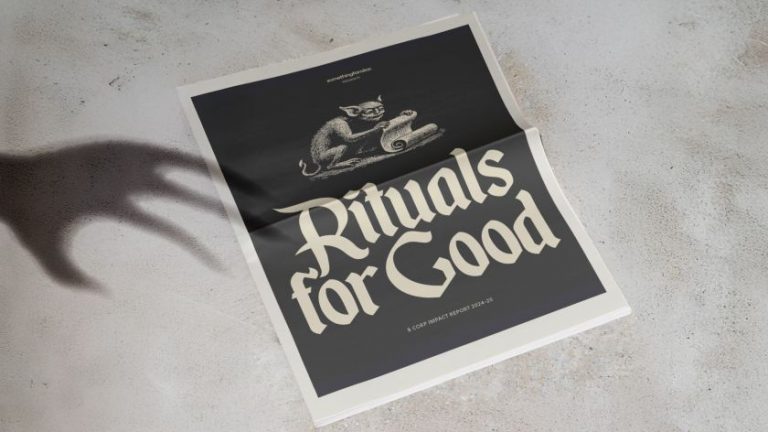A crowdfunding campaign has just launched for Margaret Calvert: Woman at Work, showcasing the career of the iconic British graphic designer. Editor Adrian Shaughnessy explains how it came about and why you should support it.
Margaret Calvert is one of the biggest names in British design history. Now 88, she’s famed for her groundbreaking work on UK road, rail, airport, and shipping signage. Her clear typography and cheerful pictograms have become an integral part of British daily life, and she’s set international standards for directional signs throughout the world.
So it’s a shock, quite frankly, that no one has ever released a book dedicated to her design work. Thankfully, that should soon change… well, at least if the creative community can provide enough support.
A crowdfunding campaign has been launched by the publishing platform Volume to create the first book dedicated to the work of designer, titled Margaret Calvert: Woman at Work. It’s off to a pretty good start, with $63,517 of $131,929 pledged at time of writing, and 23 days to go.
To learn more about this exciting project, we chatted with Adrian Shaughnessy, the book’s editor and graphic designer, writer, educator, and publisher.
The time is right
Firstly, how did the book come about? Adrian reveals that it’s been quite a while in gestation. “When we formed Unit Editions in 2009, Tony Brook and I were keen to have a Margaret Calvert monograph on our list,” recalls Adrian. “We had some discussions with her, and although she was sympathetic to the idea, she wasn’t ready to commit. Margaret only does what interests her. She’s not the sort of person who could be pressured into doing something she wasn’t ready for.”
Later, when Unit Editions came to an arrangement with Thames & Hudson to distribute their back catalogue and new titles, the publisher jumped on the idea of a Margaret Calvert book. Adrian went back to Margaret, and this time, the timing was right for her.
“She’d done a show at the Design Museum and various other things, such as a forthcoming Channel 5 documentary, all of which entailed a lot of searching in her archive. And this had encouraged her to think it might be time to green-light a book, which is fantastic, because she richly derives a book devoted to her work. It’s long overdue.”
Rare materials
Importantly, Margaret Calvert: Woman at Work won’t just cover her famous road signage work but also includes some lesser-known projects. “One of the first things you learn about Margaret is that the road signs are not the only work she’s proud of,” says Adrian. “For instance, when we discussed the editorial structure of the book, it was clear that her years spent teaching at the RCA were, in her mind, just as important.”
Consequently, there’ll be a number of unique and rare materials from Margaret Calvert’s archive in the mix. “There are some real treasures,” says Adrian. “I’m especially keen on the many drawings and sketches she did for her most famous works. I love her sketches for her typefaces. It’s thrilling to see them.”
It’s worth noting, too, that the book will take us up to the present era. “Since retiring from teaching in 2001, Margaret has taken on many solo projects,” explains Adrian. “These are mostly non-commercial. She does them because she’s supportive of the cause – such as her Keeping an Eye on Climate Change sign – or because she likes the people involved. She recently designed some watch faces, which look great. “
With so much to choose from, though, how will Adrian and Unit Editions decide what to include? There’s an unexpected answer to that question: to a certain extent, they won’t.
“We are still in the planning stage, but one of the reasons Margaret agreed to do the book was because I made it clear that it was her book,” explains Adrian. “This means much of the material is chosen by her. And we certainly won’t include anything she doesn’t want included. There have been one or two occasions when I’ve argued for the inclusion of something she’s overlooked or dismissed, but these conversations have been rational and very civilised.”
Fanatical about detail
In the course of these conversations, he’s discovered that Margaret is somewhat fanatical about detail. “I once sat next to her when she was given a major educational award, The Sir Misha Black Award in 2016,” he recalls. “The person making the introductory speech showed a series of slides of Margaret’s work. Amongst them was a sign that had been adapted slightly from the original but not by Margaret. This annoyed her, and she fumed throughout the entire event.
“Most people would have shrugged this off and accepted their gong,” he notes. “Not Margaret. I often think about that evening, and it keeps me focused on the need for accuracy. You don’t want a fuming Margaret on your case!”
That doesn’t mean Adrian will be hands-off, though. “As editor, I’m involved in all aspects of the book’s making,” Adrian adds. “But basically, it’s a team effort between Margaret, the designers Henrik Kubel and Scott Williams from studio A2/SW/HK, and me. Henrik has a long and storied relationship with Margaret, and some of the reworked typefaces she’s best known for are collaborations between the two of them.”
Finally, he agrees that Margaret Calvert isn’t the only female figure who’s been somewhat unsung over the years. “If I think historically, then there are certainly female graphic designers who deserve greater recognition,” he responds.
“I’d single out the Brazilian modernist Mary Vieira. Another favourite of mine is Jaqueline Casey, who worked at MIT from the 1950s to the 1980s. And coming up to date, I’d add Zuzana Licko for her pioneering work in type design and Rosemarie Tissi, who I think is a graphic design genius. One more: Anita Klinz – a shamefully neglected book cover designer. There are many others!”










